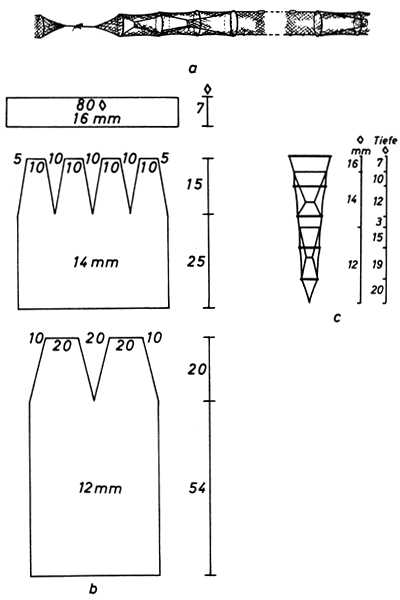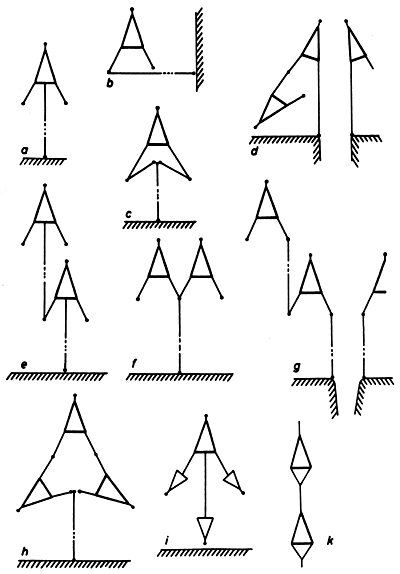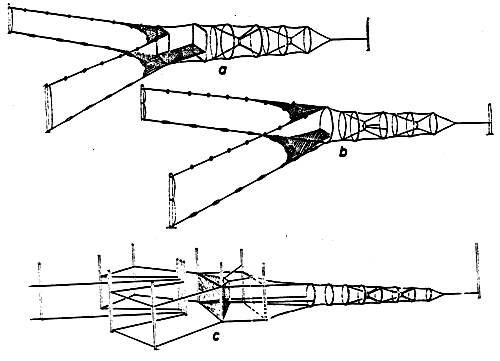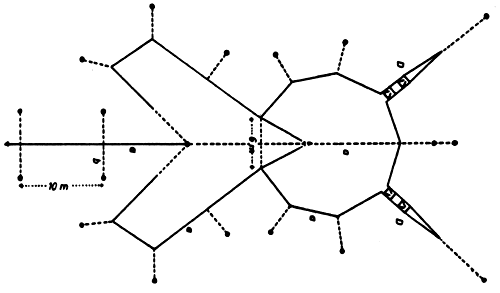by
Prof. Dr. A. v. Brandt
Leitender Direktor Institut für Fangtechnik
Bundesforschungesanstalt für Fischerei
Hamburg, Federal Republic of Germany
Some people are of the opinion that traps are the most important type of fishing gear for eel fishing in rivers or lakes as well as along the seashore. There are fishermen who own some hundreds of portable traps, or else poundnets with leading nets of more than 200 or even 600 to 1 000 m. In both cases a somewhat considerable amount of money has to be invested in equipment. Therefore, large pound nets are often operated by families or cooperatives. On the other hand small numbers of traps may be used effectively in small fisheries by commercial fishermen as well as by sport-fishermen.
Formerly, and even today, the eel traps are homemade. Therefore, we have a tremendous number of types all over the world. But there are certain fundamental requirements common to all if they are to be effective. In recent times there has been a change from hand knitted traps to ones of cut machine made netting, and, furthermore, plastic traps manufactured by factories become more and more popular especially in small fisheries.
Wooden baskets or pots are considered to be best for rivers. They are specially made for eel fishing in the current of the river and not in the side and backwaters. An anchored line some 100 m in length is set across the river. On this line the traps are fixed with by-lines of 2 m in length at a distance of 4 to 6 m apart. The baskets are placed with their opening downstream in the direction of the current. In the estuaries the baskets change their position automatically with the set of the tide. The traps are baited with small fish or shrimps according to the season and the experience of the fisherman. One fisherman can operate up to 120 baskets. The baskets are serviced 2 to 4 times a day depending on the season and the local situation. Nowadays, these wooden baskets are replaced by ones similar in type made of plastic or netting.
The eel baskets for rivers are slim, bottle-like tubes usually 1 m in length. They can be shorter or longer. Baskets of 1 m in length have a maximum diameter of 30 cm. They are made of willow rods, rattan or pine laths and have one or two funnels. At one end the baskets are closed by a wooden stopper. The opening must be large enough for the hand to enter the basket.
The spacing between the laths is decisive. According to the size of the eel to be caught, the distance can be between 2 and 8 mm. The sticks are laced together with copper wire or plastic-coated wire. The shape of the opening especially is secured and strengthened with this material. It is important that the traps are not too heavy; otherwise they will sink into the mud on the bottom of the river.
As already mentioned, these baskets have one or two funnels. To make these funnels more effective some fishermen add to the top of the funnel a small hose of small-meshed netting. Monofilaments especially are used for this purpose1.
The hose is fixed with a ring or wire to the inner opening of the last funnel and is extended by a netting yarn tied to the body of the basket. By this arrangement the funnel opening is diminished in size. The eel can squeeze itself through this flexible netting but it will be hampered by it if it tries to come out again.
Wooden baskets are often in need of repair after one year. After two years they have to be replaced. Moreover, the manufacture of these traps needs experience and patience. Not many people are able or willing to make these baskets by hand nowadays. Therefore, experiments have been made to replace the wooden laths by those made of plastics2 in order to extend the period of use. PVC in a special form to provide high resistance against low temperature was considered to be the best material. These traps were at least as efficient as wooden ones. They need less care in handling, and do not rot. They are not heavier than wooden traps which have been in use for some time in water. But their initial price is about three times as much as those made from willow. Therefore, fishery interests have tried to solve this problem in another way.
1 It may be of interest that this was the first netting made of monofilament in Germany
Plastic traps made of mould-cast lattice work have been made in many countries. At each fishery exhibition new types for fish and crabs are demonstrated. For some years now similar types for eels have been introduced in the German fishery.
These traps are composed of four pieces; there is a funnel-shaped opening with an oval cross section incorporating the first funnel; a middle piece composed of two parts with the second funnel, and an end piece for taking out the catch. This plastic trap has two galvanized iron rods fitted on the bottom to bring the trap into the right fishing position when sinking to the bottom. Sometimes fishermen replace the iron rods fitted by the factory by heavier ones when the trap is used in rivers with a strong current. The upper part of the plastic trap is a solid sheet, in order to provide cover and to give the eel a hiding place.
These plastic traps are set in rows; just like the wooden baskets, in rivers. They are also used individually in small bodies of water.
In the estuaries there are some difficulties with baiting the traps. The spacing in the machine-made plastic trap is too large and the bait falls out, when no special bag is used to hold the bait. With hand-made traps the distance of the laths can be varied as necessary, as required in the different places. Because the construction of moulds for casting plastic is very expensive, up till now one pattern of plastic basket only has been available.
In recent years another new type of trap has begun to replace the old wooden baskets in rivers. This is a trap formed from netting suitably cut to size which is retained in proper shape by five hoops spaced apart and kept in position by two spreading sticks (Fig. 10). Traps made of netting are identified by the number of meshes in the circumference. The trap under discussion has a circumference of 60 meshes.
This trap is composed of three pieces of netting, as can be seen from Figure 1b. The entrance is made of a piece of netting with a meshwidth of 14 mm (stretched mesh 28 mm). This piece is 59½ meshes broad and 5 meshes deep.
The forepart (“kitchen”) of the trap with the first funnel is made of a netting with a meshwidth of 12 mm. Naturally this piece is also 59½ meshes broad and has a depth of 40 meshes, including the funnel, 12 meshes deep. For the construction of the funnels four wedges are cut out, each 7 meshes broad in the opening. The cutting rate is 1K1B, that means alternately one knot - or point-out and one bar-cut. As can be seen in the Figure 10 cutting has to begin with a single bercut.
The last part (“parlour”) of the trap with the second funnel and the codend is made of a netting with a meshwidth of 10 mm, 59½ meshes broad and 60 meshes deep. The second funnel is out of two wedges, 15 meshes deep. The cutting rate is 1K3B, beginning with the bar-cut (Fig. 1d). The codend usually remains unshaped. The wedges of the funnels are folded inside and their meshes on the edges are joined with each other. This can be done in a simple manner.
Also the edges of the single pieces are joined and the three pieces are fixed together. The trap is mounted with 5 hoops with a diameter of 35, 32.5, 30, 27.5, and 25 cm. The netting is attached in the usual manner to the hoops.
The funnels are held in the following manner: the first one is fixed with four netting yarns (mostly double) tied to the third hoop; the second is tied to the last hoop. Using four netting yarns the opening of the first funnel has the form of a square, standing on one edge, the opening of the last one, with two yarns, is like a vertical slit.
The codend is closed by a stronger netting yarn threaded through the last meshes of the trap. Sometimes these last meshes are made by hand with double netting yarn.
The trap is stretched by two spreading sticks of 150 cm each. The sticks are fixed to the hoops of the trap.
The data given are as an example only. Variations especially in the mesh size are possible according to the local situation and the size of the eel to be caught.
It must be pointed out that there is a special relationship in the various dimensions of eel traps as will be explained later.
The mentioned type has replaced the wooden baskets. Because these baskets are cast from a boat they are also named “cast trap” (Wurfreusen). Another important type for river fisheries are the “chain traps” (Ketten-Reusen) which are fixed together like a chain as can be seen in Figure 4k.
Mention has already been made of traps which can be used in the current of rivers, mostly for eels migrating in one direction or the other. In this chapter are discussed traps which are used for eel fishing in lakes, and also in side - and backwaters of rivers or even along the seashore.
Generally speaking these are fyke nets made of netting held by vertical hoops and stretched horizontally between sticks or anchors. The netting is made from polyamide fibres or monofilament. There are also eel traps which are made from galvanized wire mesh. The life of this material is short so that it can be used for a limited period only. For this reason it is not mentioned here. Fyke nets made from polyamide, continuous fibres (23tex × 12 to 23-tex × 18) or monofilament (ø 0.45 to 0.60 mm) are important. It has been discovered that traps made from monofilament catch more eels than all other ones, just as fyke nets made from nylon yarns catch more eels than those made from cotton. It has not been established whether the explanation for this is one of visibility or whether some other physical property is involved.
The fyke nets under discussion are fitted with leading nets and/or wings in order to guide the fish into the trap. Some hundreds of traps can be used at the same time. Usually a unit consists of two or more traps (Fig. 4).
It has already been mentioned that there is a special size relationship between the various parts of a trap. The main point is that eel traps should be as long as possible. The reason is that the eel should lose contact with the first funnel before he encounters the next one. Otherwise, on making contact, he will back out using his tail as the guide.
The proportions of the different parts of the fyke nets are specified by the number of meshes. For fyke nets consisting of two parts these are as follows:
| length of the first funnel | = |  |
| length of the first part | = | length of the first funnel × 1.5 |
| length of the second funnel | = |  |
length of the second part of the trap | at least the length of the second funnel × 2.5 |
Where the fyke net has more than two funnels, the first and subsequent ones are calculated in the same manner and only the last one is longer in accordance with the specification of the second funnel as mentioned above.
Before more details are given, the calculations for the diameter and the circumference of a hoop should be mentioned. These are:
| diameter | = |  |
| circumference | = |  |
The mesh size is the length of the stretched mesh in cm1: E is the hanging factor. For fyke nets E is mostly 3/5 or 0.6.2
1 Usually the mesh size has to be calculated in mm
Along the Baltic coast and also in some lakes double traps, so-called “couples”, are used. These consist of two fyke nets, with 4 or 5 hoops each, which are connected by a leading net, with the openings facing each other (Fig. 2a). Many double traps are joined together to form a long chain up to 300 or even 500 m in length. The following specification is given for a double trap containing five hoops and two funnels and with a circumference of 80 meshes. The panels of netting are cut from three types of netting made from polyamide continuous 23tex × 6, 23tex × 9, and 23tex × 12. They can be made also from monofilament ø 0.35 mm, which may be helpful where it is found that the larvae of caddis attack the netting.
The first part of the netting at the entrance is made up of a piece with a meshwidth of 16 mm, 79½ meshes broad and 7 meshes deep (Fig. 2b).
The forepart of the trap in which the first funnel is located is made from netting with a meshwidth of 14 mm. The piece is 79½ meshes broad and has a depth of 40 meshes. The funnel is formed from four wedges of the same material each 10 meshes broad at the opening and 15 meshes deep (ca 1/5 of the circumference). The cutting rate is 1K1B, beginning with a bar-cut.
The afterpart of the trap with the second funnel and the cod end is made of netting with a meshwidth of 12 mm, 79 ½ meshes broad and 74 meshes deep, including the funnel. For the construction of the funnel two wedges are cut out, each 20 meshes broad. The cutting rate is 1K2B, beginning with the two bar-cuts.
The wedges are turned inside and the edges are joined together as usual. The five hoops have a diameter of 45, 35, 30, 28 and 27 cm. The hoops are fixed in the manner shown in Figure 2c. The funnels are secured with four or two netting yarns fastened to the third and fifth hoop, respectively.
The leading net between the two traps has a length of ca 3 m and is 25 meshes deep. The meshwidth is 16 or 18 mm. The hanging ratio is ½ or ⅓. The floatline, e.g. polyamide, plaited, ø 5 mm, has only a few floats. The lead line is weighted with lead in a distance of 30 cm. Mostly patentlines (8–13 kg per 100 m) are used. It is very important that the line makes firm contact with the bottom. The leading net is fixed to the trap in such a manner that it ends at the beginning of the first funnel.
Each row of double traps is securely fastened at each end. Usually, two fishermen work in partnership. They can own 700 or even 1 000 double traps.
A successful eel trap, especially for lakefishing, is a unit consisting now of three traps but originally of four. A large main trap (circumference 80 meshes) is combined with two (originally three) smaller ones (circumference 60 meshes). The combination of traps and connecting leading nets produces a pattern something similar to a cross as can be seen from Figure 3a. Nowadays the trap nearest to the shore is dispensed with because it had the lowest efficiency. The two types of traps are cut from machine-made netting. The main trap with a circumference of 80 meshes has an entrance made of netting with a meshwidth of 30 mm. The piece is 79½ meshes broad and has a depth of 5 meshes (Fig. 3b).
The forepart of the trap, including the first funnel, is made of netting with a meshwidth of 25 mm. This piece of netting is also 79½ meshes broad and, including the funnel, 37 meshes deep. For the construction of the funnel four wedges are cut out as shown in Figure 3b. The cutting pattern is the same as that already mentioned: 1K1B, beginning with a bar-cut.
The afterpart of the trap, including the second funnel and the cod end, is made of netting with a meshwidth of 20 mm, 79½ meshes broad and 71 meshes deep including the funnel. For the formation of the funnel, wedge pieces are cut out, each 8 meshes broad and 19 meshes deep. The cutting ratio is 1K1B, beginning with a knot-cut.
After cutting, the wedges are folded inside and joined together in the same manner as the edges of the netting. The five hoops have a diameter of 92, 86, 61, 59 and 58 cm. The funnels are tied by four or two netting yarns to the third and fifth hoop respectively.
The smaller traps with a circumference of 60 meshes are cut in a similar manner (Fig. 30). The entrance is made of netting with a mesh width of 30 mm. The piece is 59½ meshes broad and 5 meshes deep.
The forepart of the trap including the first funnel is made of netting with a meshwidth of 25 mm, 59½ meshes broad and 29 meshes deep. The four wedges for the construction of the funnel are cut in the manner shown in Figure 30. The cutting ratio is 1K1B, beginning with a knot-cut.
The afterpart of the trap with the second funnel and the codend is made of netting with a meshwidth of 20 mm, 59½ meshes broad and 57 meshes deep, including the funnel. For the funnel wedges are cut out as can be seen in the drawing. The cutting ratio is 2K1B, beginning with a bar-cut.
The cut netting is joined together as mentioned above. The five hoops have a diameter of 68, 57, 46, 44 and 42 cm. The funnels are tied by four or two double netting yarns to the third and the last hoop respectively.
The three traps are joined together by wings extending from the main trap. The wings are made of netting with a meshwidth of 25 mm. The netting is made of polyamide 23tex × 12 and has a depth of 15 meshes. The wings have a length of 4.5 m unmounted, and of 3 m mounted. The hanging factor is ⅔, that means that the meshes are nearly quadratic in shape. The main trap has also a leading net of the same material and the same hanging factor. The length unmounted is 24 m and mounted 16 m. The leading net begins in the opening of the main trap and at its other end has two loops by means of which it can be fixed to a stake driven into the bottom.
One end of the wings is attached to the outer half of the first hoop of the main trap. The other end is fixed to the middle of the entrance of the smaller trap, with some meshes fixed at the entrance itself and extending into the beginning of the first funnel.
There are many more types of eel traps: for instance, in Denmark there are very long ones with more than 10 hoops. There are also smaller ones with wings connected at the beginning by special netting (tongue) which is the basis for larger type traps which are discussed here.
The traps mentioned above can be combined to form units with high efficiency, especially near the outlets of lakes. In these combinations the arrangement of wings and guiding nets is important. Figure 4 illustrates some arrangements which have been made to increase the efficiency of traps in such systems. In fact, the double traps and the cross traps are also samples of such systems, but there are many more, as can be seen in the diagrams. The object is to guide eels which avoid the entrance of one trap into another. It has been mentioned that double traps are joined together to form rows, some hundred metres long. However, the “chain-traps” used by fishermen in rivers are not as long as this (Fig. 4k). In this case, four to six traps are combined in a distance of 2 m without leading net in the manner shown in Figure 4k.
The actual system chosen for each locality depends on the site conditions obtaining where the eels have to be caught. Finally it has to be pointed out that the systems shown in Figure 4 can be combined together to form even larger units.
The length of traps can be increased from ones with 5 hoops to ones with 6 hoops and 3 funnels. In this case the first hoop is made horse-shoe in shape the bottom rod being made of iron. Such an entrance can have a height of more than 1 m. Furthermore, as already mentioned above, Danish coastal fishermen employ fyke nets for eel fishing which contain more than 10 hoops.
Another idea to increase the size of the fyke nets is to provide an additional catching arrangement before the entrance to the first hoop. To a certain extent a trap fitted with wings formed like hooks (Fig 4c) can be considered as an enlarged trap. This arrangement usually has in addition the triangular area between the trap proper and the beginning of the wings filled in with a piece of netting laced across the top as well as at the bottom (Figs. 5a and 5b). It is usual to provide a rectangular chamber before the first hoop (Fig. 5a). The top of this chamber may be either closed or open but the bottom is always closed with netting. Sometimes two such additional chambers are used (Fig. 5c). In this case a third retarding device is needed in the form of a step or in the form of a vertical slit. The construction of these so-called “box traps” varies very much according to the local situation. The larger extended fyke net arrangements are set especially at the outlets from lakes to catch the migrating eels.
Off the Baltic coast Danish and German fishermen operate very large pound nets for eel fishing (Fig. 6). The local name is the Danish word “bundgarn”: this means bottom-net. In this case very large chambers are set up to concentrate the fish which are guided into it by leading nets which are 600 m in length and more, and in depth up to 6 m. The capture of the eels takes place in two fyke nets with 4 to 6 hoops which form part of the installation. Further details of such installations can be found in the FAO Catalogue of Fishing Gear Designs.
These pound nets are used especially to catch migrating eels in autumn. Fishing at this time is very much influenced by weather conditions. The highest catches are made during the new moon beginning with the lart quarter. Dark nights with winds directed to the land are especially effective.
McGrath pointed out that it was desirable to have the top of the leader line 50 cm over the water for silver eels, but the top of the leader can be at the surface for brown eels.
Deelder referred to the composition of the hoop materials and pointed out that in Holland fishermen constructed fyke nets up to 3 m in diameter with split willow hoops.

Fig. 1 Eel trap for rivers.

Fig. 2 Double trap.

Fig. 3 Cross trap.

Fig. 4 Systems of traps for eelfishing.

Fig. 5 Box traps.

Fig. 6 Danish “bundgarn” for eels.